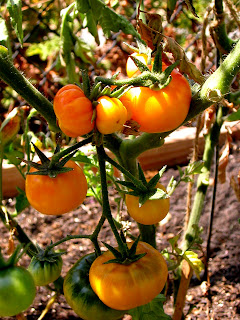
How is it that a 15x10' plot of land can offer such a range of experiences, from the most blissful when I see new dahlia blossoms emerging, to the most dreadful, when a much awaited, heavy Hillbilly flame heirloom tomato, is on the verge of ripening, and in my eagerness to see it's changing colors, I turn it over only to discover a bed of roly-polies feasting on the flesh that was to be mine? I've had a few major disappointments in gardening by now to not think that the end of the world is near, but still, I REALLY wanted that tomato, and I am REALLY sad that it is now sitting in the bellies of creatures who I'm sure won't appreciate it as much as I would have.
I suppose I should look on the bright side. I did, after all, bring home a radish today as a fruit of my labors.





















